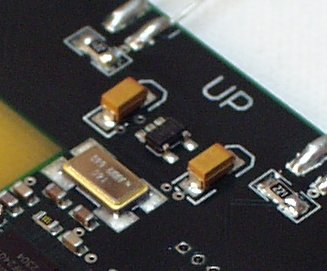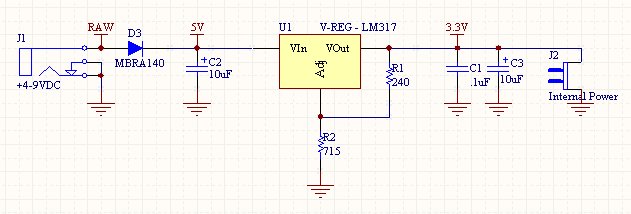Reverse Protection Diodes
Description:
These large current, high voltage diodes can be used for a multitude of purposes. Really, we just use them for reverse polarization protection.
Most systems that we play with are DC system - whatever board requires 'X' voltage (3.3V for example). The board expects the DC voltage in a certain way. VCC in one spot, ground in another. If you reverse this (attaching VCC where GND should be, etc) BAD things happen. If you're lucky, there will be a massive short somewhere and nothing major will smoke. If you're unlucky, the board will go up in smoke and some things might explode. In practice, most things heat up (no smoke or explosion), but are instantly killed. So now you've got a board that doesn't work but it can be very hard (nye, nearly impossible) to tell what is damaged and what can be fixed.
Obviously there must be a to prevent this from happening. Enter diodes...
These pieces of silicon allow current to flow in one direction only. Quite simply, VCC is allow through but GND is not. Why don't we put a diode on every VCC? Well a diode can cause a 0.7V drop (that's what they teach you in silly eng school at least) on the power line. So if you are dealing with a really low-power system, 0.7V drop can be too much.
There are other ways to protect against reverse polarization like polarized connectors and certain voltage regulators have protection built in. But it you're designing something for mass-market where you don't know who will be connecting what, a reverse protection diode is cheap and easily designed into a board.
Here you can see the diode in place.
These type diodes can also be used, four at a time, in an h-bridge configuration. I don't have a good image (somebody help me out), but an H-Bridge takes an AC signal and rectifies it to a DC signal (neat trick actually). An H-Bridge circuit will also work with a DC supply.
Diodes come in all shapes and sizes. For this posting, we only care about cheap, bulky, large current diodes. These diodes can handle 1-2A each and are cheap. For some our mass designs, we prefer the surface mount diodes (MBRA140). The MBRA140 comes in an SMA package (hopelessly confused with the SMA antenna connector - who came up with this?!). Many other diodes come in axial packages perfect for bread boarding. They all work the same - there is an anode and a cathode. I was always told to remember the anode was the arrow and current flows in the direction of the arrow. Cool huh?
These are small, low-noise, low drop out, voltage regulators. Perfect for simple applications, they require only a 4.7uF output capacitor (for stability) and have a 7V maximum input. Cheap and small, we use them in many applications in unison with the 10uF Tantalum Capacitor.
These little guys output a max of 150mA which is fairly impressive for such a small footprint. They have an enable pin that can allow for power saving, but the quiescent current is only 85uA so we usually just pull the enable pin high.
Documents:
TPS763xx Datasheet
Footprints:
SFE Footprint Library
FP Name: SOT-23
Manufacturer Info:
TI part # : TPS76350DBVT (5V Output)
Supplier Info:
Digikey part # : 296-2707-1-ND (5V)
Single Piece Price : $0.84
Related Items:

